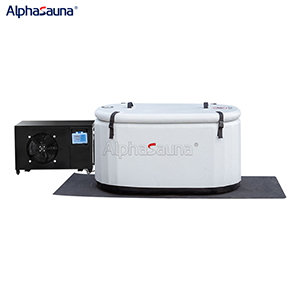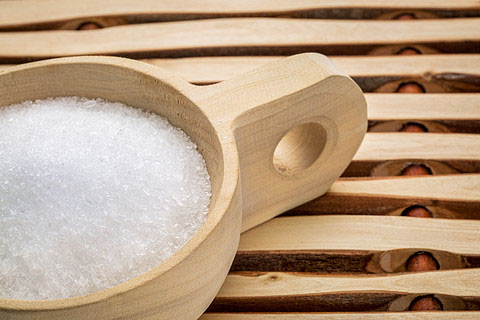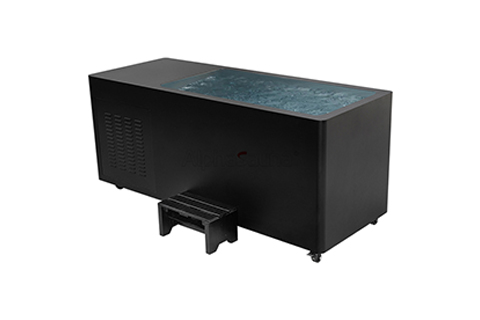An ice bath is a form of cold therapy that involves immersing the entire body in ice-cold water. This method, with a long history of use, is highly effective for post-exercise recovery and daily health care. It helps reduce muscle pain and inflammation through the stimulation of cold water and low temperatures, while also improving blood circulation and promoting faster body recovery.
Recently, many people have started adding a seemingly inconspicuous ingredient to their ice baths—Epsom salt. This addition is gaining popularity among ice bath enthusiasts, as it is believed to enhance the recovery effects of ice baths and improve overall recovery capabilities. In this article, Alphasauna will explore the principles and benefits of combining Epsom salt with ice baths and explain why this practice is becoming increasingly popular.
What Are Epsom Salts?
Epsom salt, also known as magnesium sulfate, is an inorganic compound made up of magnesium and sulfate ions. Although it shares the term "salt" with the edible salt used in daily cooking, Epsom salt is distinct in its composition and health benefits. It is a mineral compound known for its numerous health advantages.
One of the key benefits of Epsom salt is its magnesium content. Magnesium is an essential mineral involved in over 300 physiological processes in the human body. It supports normal nerve, muscle, and heart function and plays a crucial role in energy metabolism, bone health, blood sugar regulation, and inflammation control.
Although magnesium is present in many foods, some people do not receive enough magnesium daily due to factors such as magnesium loss from refined foods or inadequate vegetable intake, which can lead to various health issues. In addition to dietary sources, Epsom salt can be absorbed through the skin. When Epsom salt is dissolved in water, it releases magnesium and sulfate ions, which can penetrate the skin during soaking. This process may help relieve muscle tension and improve blood circulation.
It's important to note that the skin acts as an effective barrier, typically preventing large molecules or ions from passing through easily. Therefore, the absorption of magnesium through the skin is quite limited, and there is no risk of excessive magnesium absorption from Epsom salt baths.

Benefits of Epsom Salts in an
We all know that ice baths offer numerous health benefits, but how does adding Epsom salts enhance these effects? Alphasauna suppliers explain the benefits from the following perspectives:
Muscle Recovery
Ice baths lower body temperature and slow blood flow, which effectively relieves muscle microtrauma, fatigue, and reduces muscle pain and inflammation. When Epsom salts are added to ice baths, magnesium sulfate helps reduce lactic acid buildup after exercise, thereby regulating muscle and nerve function, enhancing muscle relaxation, and promoting faster recovery.
Anti-Inflammatory Effect
Ice baths are popular for reducing inflammation after exercise because the low temperature decreases blood flow, limiting the reach of inflammatory factors. The sulfate ions and magnesium in Epsom salts are believed to have anti-inflammatory properties, which can inhibit the production of inflammatory factors. Combined with the anti-inflammatory effect of the ice bath, this can further reduce joint and muscle swelling.
Promote Blood Circulation
Epsom salts and ice baths represent two different extremes in promoting blood circulation. During an ice bath, the low temperature causes blood vessels to contract, directing more blood to the core and helping to reduce inflammation and swelling. Once the body exits the ice bath and begins to return to its normal temperature, magnesium ions absorbed from the Epsom salts help relax blood vessels, speed up vascular dilation, and smooth out blood flow. This rebound effect enhances overall blood circulation.
Promote Skin Health
While Epsom salts added to ice baths may not have the same pronounced effect on the skin as hot baths, the cold temperature of the ice bath tightens the skin and reduces pore appearance. Epsom salts provide additional soothing effects and accelerate the removal of metabolites, contributing to a cleansing effect.
Promote Relaxation
Magnesium in Epsom salts helps regulate neurotransmitters in the brain, which are crucial for controlling emotions and relaxation. When combined with the deep effects of an ice bath, this can further reduce stress and anxiety, promoting a sense of psychological calmness.


Guidelines for Using Epsom Salt Ice Baths
Understanding the benefits of Epsom salt is crucial, but it's also important to use the correct amount when adding it to an ice bath. Using too little Epsom salt may not provide significant soothing and anti-inflammatory effects, while using too much can cause skin irritation or dryness, especially for those with sensitive skin. Follow these steps for an effective Epsom salt ice bath:
1.Prepare the Water
Fill the bath with water. The recommended temperature is between 10°C and 15°C (50°F and 59°F).
2.Add Epsom Salt
Pour 1 to 2 cups (240-480 grams) of Epsom salt per gallon (3.8 liters) of water. Stir well to ensure the salt is fully dissolved. Tip: Adjust the amount of Epsom salt based on the water volume to avoid using too much or too little. Overuse can cause skin irritation.
3.Soak
Immerse yourself in the ice bath for 10-15 minutes. Adjust the duration based on personal tolerance and comfort, but avoid prolonged exposure to prevent discomfort from excessive cold.
4.Post-Bath Care
After soaking, dry your body with a towel and dress warmly to help your body return to its normal temperature. You may also drink a hot beverage to aid in warming up.
Epsom Salt Bath FAQ
Are there any side effects after taking an Epsom salt bath?
Generally, there are few risks associated with adding Epsom salts to an ice bath or hot water. However, you should be cautious about the amount you use. Avoid using Epsom salts if you have open wounds, skin infections, or burns.
Will Epsom salts damage the bathtub?
Yes, Epsom salts can damage certain types of bathtubs over time. While traditional hard material bathtubs, such as wooden ice buckets, stainless steel ice bath tubs, and acrylic tubs, can safely handle Epsom salts, inflatable or fabric bathtubs may suffer from damage, such as leaks or deterioration, due to the salts.
Do you need to add Epsom salts every time you take an ice bath?
This depends on your personal preferences and needs. Generally, adding Epsom salts 1-2 times a week is effective, but you can adjust the frequency based on your physical condition and goals.
How do I find the right cold water bath tub?
Search for reputable cold water bath brands online or contact Alphasauna. We offer high-quality ice bath kits and can answer any questions you may have about our products.





